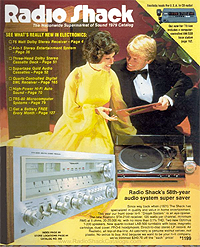 Last night, I was fretting over the ugly rumor that RadioShack was about to change its name to The Shack. Today the company issued a 700-word press release announcing its plans, and…I still can’t tell whether it intends to change the names of its thousands of stores or not.
Last night, I was fretting over the ugly rumor that RadioShack was about to change its name to The Shack. Today the company issued a 700-word press release announcing its plans, and…I still can’t tell whether it intends to change the names of its thousands of stores or not.
Some quotes from the release:
RadioShack Corporation (NYSE: RSH) will unveil its new brand creative platform, “THE SHACK,” on August 6, supported by an integrated television, print and digital media schedule, as well as a high-profile, three-day launch event taking place in New York City and San Francisco.
Remind me again what a brand creative platform is again?
Trust is a critical attribute of any successful retailer, and the reality is that most people trust friends, not corporations. When a brand becomes a friend, it often gets a nickname – take FedEx or Coke, for example.
Not terribly clarifying considering that Federal Express completely shucked its old name and is now FedEx Corporation, while the folks at the Coca-Cola Company are equally pleased if you call their product Coca-Cola or Coke.
“Our customers, associates and even the investor community have long referred to RadioShack as ‘THE SHACK,’ so we decided to embrace that fact and share it with the world,” said Lee Applbaum, RadioShack’s Chief Marketing Officer.
Fair enough. But will your embracing and sharing involve the changing of signage? How will you answer the phone? Also, does the fact you call RadioShack “RadioShack” but spell the new name “THE SHACK” mean that your customers, associates, and the investor community have long bellowed that nickname at the top of their lungs?
This creative is not about changing our name. Rather, we’re contemporizing the way we want people to think about our brand.
Semantics question: Does the fact it’s not about changing your name mean that you aren’t changing your name?
We have tremendous equity in consumers’ minds around cables, parts and batteries, but it’s critically important that we help them to understand the role that we play in keeping people connected in this highly mobile world.
Okay, that makes sense–if I were RadioShack, I’d emphasize mobile stuff over batteries and cables, too. But how does calling yourself THE SHACK help achieve that goal?
“We’ve partnered with RadioShack to develop a creative platform that will cause people to take another look at THE SHACK. Everything about the advertising – the media, format, style, music and tone – will contribute to a new interpretation of the brand,” said Greg Stern, [CEO of THE SHACK’s ad agency. “Everyone knows RadioShack. Our job is to communicate what THE SHACK stands for today.”
I’ve been in my local Radio Shack RadioShack THE SHACK recently, and the biggest difference I noticed over Radio Shack RadioShack THE SHACK of the past is that they no longer badger you for your home address. Can I get some clarification on how changing the music in the commercials will make me a happier, healther customer of Radio Shack RadioShack THE SHACK?
To bring the new creative strategy to life, RadioShack will host Netogether, a three-day event taking place in New York City’s Times Square and San Francisco’s Justin Herman Plaza on August 6, 7 and 8. The event will connect the cities with two, massive, 17-foot laptop computers with webcams that allow live video and audio exchanges. Netogether will feature live music, celebrity appearances and unique contests to demonstrate how technology can keep people connected – even 3,000 miles apart. Consumers are invited to visit the event and chat with friends or family via the laptops, or to join in the conversation online at www.radioshack.com/theshack, where they can offer real-time comments on the live video feeds.
Now you’re talking! I’ll try to visit the 17-foot laptop in San Francisco later this week and report on it here.
Back in the 1970s and 1980s, Lewis Kornfeld, former president of Radio Shack RadioShack THE SHACK, published a column called “Flyerside Chat” in the company’s weekly circular. It was remarkably earnest and direct, and bizarrely free of marketingese–a sort of a corporate blog decades before anyone knew what a corporate blog was. Now the company’s trying to tell me news in wording so laden with buzzwords that I can’t figure out whether it plans to take down the RadioShack sign at the location a mile from here and replace it with one that says THE SHACK or not. Wouldn’t a friend who was changing his or her name tell you so rather than tapdancing around the question? Can anyone help me out here?
Possible clue: www.theshack.com is taking me to RadioShack.com…
 Back in May, the first edition of TWTRCON–the conference on Twitter for business which I’m proud to have come up with–was held in San Francisco. It was a hit. And Modern Media, the events’s organizers, are taking the show to Washington DC. TWTRCON DC 09 will be held at the Grand Hyatt Washington DC on October 22nd; the keynote speaker is Craigslist founder Craig Newmark, and folks from Dunkin Donuts, the NHL, H&R Block, Intuit, and PepsiCo have agreed to share their knowledge, with more to come. As before, the topic is how to leverage the power of Twitter to make your business more successful, but given the venue, there will also be discussion of Twitter and government.
Back in May, the first edition of TWTRCON–the conference on Twitter for business which I’m proud to have come up with–was held in San Francisco. It was a hit. And Modern Media, the events’s organizers, are taking the show to Washington DC. TWTRCON DC 09 will be held at the Grand Hyatt Washington DC on October 22nd; the keynote speaker is Craigslist founder Craig Newmark, and folks from Dunkin Donuts, the NHL, H&R Block, Intuit, and PepsiCo have agreed to share their knowledge, with more to come. As before, the topic is how to leverage the power of Twitter to make your business more successful, but given the venue, there will also be discussion of Twitter and government.
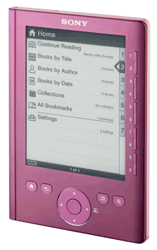 If Sony is a bit nonplussed over all the attention for
If Sony is a bit nonplussed over all the attention for 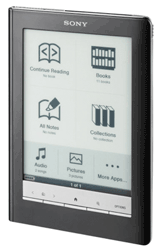 Now Sony’s striking back with a
Now Sony’s striking back with a 
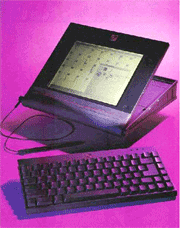 At the moment, Apple’s tablet is not a real product but a gumbo of
At the moment, Apple’s tablet is not a real product but a gumbo of 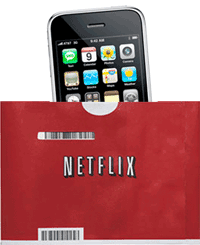 Rumor has it that
Rumor has it that  Nikon announced four new point-and-shoot cameras today, one of which has a truly striking feature: a built-in projector. The $429
Nikon announced four new point-and-shoot cameras today, one of which has a truly striking feature: a built-in projector. The $429 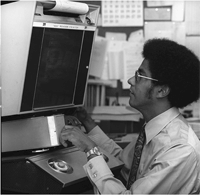 I recently reacquainted myself with a gadget that was once one of my primary forms of data retrieval (a microfilm reader) in a place I don’t spend nearly enough time at (my local public library). The experience left me both grateful for the breadth and the precision of Web search–and a little nostalgic for the pleasant randomness inherent in microfilm in specific and libraries in general.
I recently reacquainted myself with a gadget that was once one of my primary forms of data retrieval (a microfilm reader) in a place I don’t spend nearly enough time at (my local public library). The experience left me both grateful for the breadth and the precision of Web search–and a little nostalgic for the pleasant randomness inherent in microfilm in specific and libraries in general. One of my personal heroes in the whole history of technology is Christopher Sholes. He didn’t invent the microprocessor or the LCD or cellular communications–he’s the man who gave the world the first QWERTY keyboard, back in 1867. And even though new approaches to input such as multi-touch screens can be pretty cool, I think that QWERTY will be with us for a long long time to come.
One of my personal heroes in the whole history of technology is Christopher Sholes. He didn’t invent the microprocessor or the LCD or cellular communications–he’s the man who gave the world the first QWERTY keyboard, back in 1867. And even though new approaches to input such as multi-touch screens can be pretty cool, I think that QWERTY will be with us for a long long time to come. Last night, I was
Last night, I was